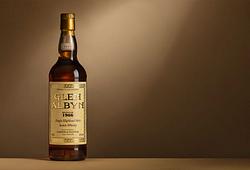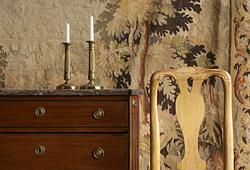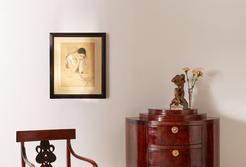Ingrid Ruin
Ingrid Ruin, oil on canvas, signed and dated -07.
Portrait. 45 x 46 cm
God kondition.
More information
Ingrid Ruin was born in Pori, Finland in 1881. In addition to studying at the Finnish Art Association's drawing school in Helsinki 1897-1901 and at the Academy of Fine Arts in Copenhagen 1901-03, she uniquely studied with two of the foremost Nordic artists of her time, Albert Edelfelt (1854-1905) and Anders Zorn (1860-1920).
The studies for Albert Edelfelt were carried out in 1903-05 and continued until Edelfelt's death.
After that, Ingrid Ruin came as an art student to Anders Zorn in Mora. There she was not only a student but also worked until 1907 as Anders Zorn's artistic assistant. It shows how highly Zorn valued Ingrid Ruin as a promising artist. Anders Zorn was enormously successful at this time, and around these years he was commissioned to portray American presidents Grover Cleveland (1899) and William Howard Taft (1911).
In 1907, during Ingrid Ruin's last year with Anders Zorn in Mora, she executed the auction's beautiful and poignant portrait painting. It is not clear who sat as a model for the painting. Some observers believe that the oil painting may depict Anders Zorn's wife Emma Zorn, based on Ingrid's Ruin's history in Mora and that the painting is dated 1907. The auction's oil painting and the contemporary "Moraculla standing next to the table" (1907) are clear examples of Anders Zorn's importance to Ingrid Ruin's art. The paintings from 1907 are among the central works in Ingrid Ruin's production. She will thereafter throughout her career work in this particular Zorn-inspired style, with a driven, broad and fast color brush, showing her inspiration from the master Zorn, long after Anders Zorn is deceased.
After the years with Anders Zorn in Mora, Ingrid Ruin moved to Copenhagen, from where she traveled between her exhibitions in Germany, France and Italy, among others. In Copenhagen, Ingrid Ruin married Finnish engineer Eric Tigerstedt in 1919. In 1931 she remarried, to Torsten Gottlob Hagelberg and moved to Sweden. Around 1907, Ingrid Ruin's parents built a yellow log house on the Finnish island of Härligö for their daughter. Zorn's own studio in Mora stood as a model for Finnish house building. Art historians have described that Anders Zorn and Carl Larsson sailed together to Härligö one summer to visit Ingrid Ruin's home. They then docked at the now dilapidated steamboat wharf below "Zornhuset" at Härligö.
Ingrid Ruin held solo exhibitions in Stockholm in 1911, 1914 and 1924 and in Gothenburg in 1943. In addition, she participated in several international exhibitions in Finland, St. Petersburg, Copenhagen, Oslo, Berlin and Rome. Ingrid Ruin is best known for her portraits and national romantic motifs, especially with women, probably after impressions from her painting studies with Anders Zorn.
Ingrid Ruin's art is represented at the Serlachius Foundation in Helsinki and in several museums in Finland.
Ingrid Ruin's artistry was rediscovered in 2005, in connection with her first retrospective exhibition in Finland, at the Riihimäki Art Museum. The art museum thoroughly mapped Ingrid Ruin's artistry and borrowed oil paintings from both Finnish and Swedish art collections.
"Riihimäki Art Museum's summer exhibition 'Ingrid Ruin (1881–1956) – Anders Zorn's student' is the artist's first major exhibition in decades. The exhibition presents a female artist active in the early 20th century, who was a student of Anders Zorn (1860–1920). The exhibition presents Ingrid Ruin's oil paintings, watercolours, drawings and graphics as well as the works of Anders Zorn. The works in the exhibition have been borrowed from private collections, the Riihimäki Art Museum's collections and other public collections. In connection with the exhibition, an exhibition catalog in Finnish and Swedish will be published.
Ingrid Ruin, who was born in Pori in 1881 and worked in Finland mainly until 1931, lived in Sweden in later decades. Ingrid Ruin studied in Finland at the Art Association's drawing school in Helsinki (1897–1901) and the Academy of Fine Arts in Copenhagen (1901–1903). An important study phase was the studies in Mora, Sweden under Anders Zorn from 1905. Ruin's main output consists of paintings depicting women in national costume, portraits and self-portraits. During the artist's lifetime, Anders Zorn's influence has been mentioned in connection with both painting style and motif circle."
From exhibition text, Riihimäki Art Museum 2005.



































